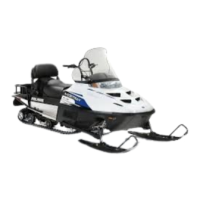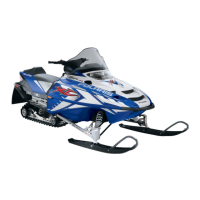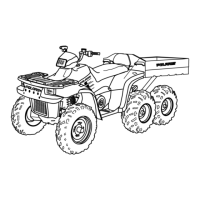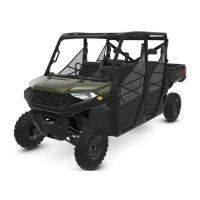How to fix slow clutch engagement on a Polaris Widetrack LX Offroad Vehicle?
- SshannonhannahSep 23, 2025
To address slow, easy clutch engagement on your Polaris Offroad Vehicle, use fast, aggressive throttle to engage the clutch.
How to fix slow clutch engagement on a Polaris Widetrack LX Offroad Vehicle?
To address slow, easy clutch engagement on your Polaris Offroad Vehicle, use fast, aggressive throttle to engage the clutch.
Why does my Polaris Widetrack LX engine lack power?
If your Polaris Offroad Vehicle engine lacks power, consider these potential causes: * **Spark Plug:** A fouled or defective spark plug can cause power loss. Try changing the spark plug and test the operation. * **Fuel Filter:** A clogged fuel filter can restrict fuel flow, especially at high RPMs. Check the fuel filter flow by disconnecting the hose and draining about 1/2 cup of fuel. The fuel flow should be steady and encompass the entire diameter of the fuel line. If not, replace the filter. * **Clutching/Carburetor and fuel pump:** For issues related to incorrect clutching or carburetor and fuel pump problems, it's best to see your dealer, as adjustments to change power output are not available.
Why is the steering on my Polaris Offroad Vehicle so heavy?
If the steering on your Polaris Offroad Vehicle feels heavy, here are a few things you can check: * Inspect the skags and skis for any damage. * Look for any binding in the front suspension shafts and steering components. Grease all pivot points after elevating the front of the machine. * Verify the sag dimension and adjust the torsion spring blocks or install optional torsion springs to achieve the correct sag dimensions. * Decrease the IFS preload.
Why does the front end of my Polaris Widetrack LX Offroad Vehicle push?
If your Polaris Offroad Vehicle's front end pushes, consider the following: * Check for worn skags. * Inspect for binding in the front suspension shafts and steering components, and grease all pivot points after elevating the front of the machine. * Verify the sag dimension and adjust the torsion spring blocks or install optional torsion springs to achieve the correct sag dimensions. * Increase the IFS preload.
Why does my Polaris Widetrack LX dart from side to side?
If your Polaris Offroad Vehicle darts from side to side, check the following: * Ensure the skis are properly aligned. * Check for binding front suspension shafts and steering components, and grease all pivot points after elevating the front of the machine. * Make sure the skags are straight on the skis.
What to do when towing with a Polaris Widetrack LX Offroad Vehicle at low RPM?
When towing with your Polaris Offroad Vehicle, avoid towing in deep snow. Use fast, aggressive throttle to engage the clutch.
What causes too much weight transfer when climbing with a Polaris Offroad Vehicle?
If your Polaris Offroad Vehicle experiences too much weight transfer when climbing, verify the sag dimension. Adjust the torsion spring blocks or install optional torsion springs to achieve correct sag dimensions.
What causes too little weight transfer when climbing with a Polaris Widetrack LX?
If your Polaris Offroad Vehicle experiences too little weight transfer when climbing, verify the sag dimension. Adjust the torsion spring blocks or install optional torsion springs to achieve correct sag dimensions.
Why does my Polaris Widetrack LX have erratic engine RPM during acceleration?
If your Polaris Offroad Vehicle experiences erratic engine RPM during acceleration or load variations: * **Drive Clutch Binding:** If the drive clutch is binding, disassemble it to inspect the shift weights for wear and free operation. Consult your dealer. * **Driven Clutch Malfunction:** If the driven clutch is malfunctioning, replace the ramp buttons and rollers. Consult your dealer.
Why does the rear suspension on my Polaris Widetrack LX Offroad Vehicle ride too stiff?
If the rear suspension on your Polaris Offroad Vehicle rides too stiff, here are a few things to check: * Check for binding suspension components and grease all pivot points. * Verify the sag dimension and adjust the torsion spring blocks or install optional torsion springs to achieve the correct sag dimensions. * Decrease shock compression damping.
| Brand | Polaris |
|---|---|
| Model | Widetrack LX |
| Category | Offroad Vehicle |
| Language | English |
Provides guidance on manual storage, operator training, maintenance, and registration.
Discusses Polaris' commitment to environmental education and responsible operation.
Addresses snowmobile noise standards and owner responsibility.
Details Polaris' efforts to reduce emissions and invites collaboration.
Guides users to record VIN, engine serial number, and key number.
Explains signal words and symbols used for safety warnings.
Warns about entanglement hazards with the track and recommends dealer service.
Advises stopping the engine before performing adjustments to avoid injury.
Lists essential survival equipment and advice for riding in remote areas.
Explains the importance of proper rider posture for control and safety.
Discusses the importance of helmets, eye protection, and appropriate clothing.
Warns about the impact of excess weight on steering and passenger placement.
Advises against operation by individuals with cognitive or physical disabilities.
Details single-rider (1-Up) and two-rider (2-Up) configurations and responsibilities.
Warns about the dangers of high speeds, especially at night or in poor visibility.
Covers awareness of obstacles, road crossings, and ice conditions.
Provides training and equipment advice for riding in mountainous terrain.
Warns about steering interference from ice/snow and suggests solutions.
Advises caution and slower speeds on slippery surfaces for better control.
Provides guidance on climbing, crossing, and descending slopes safely.
Details weight shifts and braking techniques for safe downhill riding.
Explains the importance of the clutch guard for operator protection.
Advises against operating without the drive belt and mentions dealer servicing.
Warns against removing the intake silencer/filter to prevent engine damage.
Recommends dealer servicing for clutches due to their complexity.
Advises loosening skis/track from ice/snow before driving.
Explains how body weight affects control and how maneuverability varies.
Explains the need for snow cover for lubrication and cooling, warning of damage.
Provides tips for getting unstuck in deep snow.
Covers general responsible riding practices, group riding, and security.
Provides charts to determine dangerous temperature conditions for riding.
Explains the purpose and location of various warning labels on the snowmobile.
Warns about entanglement hazards with the track and falling from the seat back.
Advises on safe reverse operation, including shifting and turning.
Lists critical warnings for reading the manual, speed, alcohol, and protective gear.
Identifies key controls on the handlebar and dashboard.
Illustrates and describes features like headlight dimmer and electronic reverse.
Explains the location and operation of the fuel valve for storage.
Labels and identifies major external components of the snowmobile.
Details how to adjust the backrest for operator or passenger use.
Advises on securing cargo and respecting weight limits.
Explains break-in, greasing, and customizing suspension settings for ride quality.
Lists the components of the Independent Front Suspension system.
Outlines options for adjusting front shock spring preload.
Identifies parts of the front shock absorber assembly.
Explains how spring preload affects ski-to-ground pressure.
Discusses changing front springs for stiffness adjustment and tool requirements.
Covers how rider weight, style, and conditions affect rear suspension setup.
Offers tips on rail slides, bogie wheels, and lubricating pivot points.
Stresses the importance of correct track tension for handling.
Details how to set rear spring settings for proper sag and ride comfort.
Provides steps for adjusting the standard handlebar angle.
Explains the function of skags and their replacement when worn.
Mentions availability of accessories to enhance the riding experience.
A table listing items to inspect before each use with corresponding page numbers.
Emphasizes reading the manual for safe and enjoyable operation.
Emphasizes reading the manual for safe and enjoyable operation.
Details how to check throttle lever function and return to idle.
Instructs on testing the throttle safety switch system before operation.
Explains how to check brake lever travel and feel for proper function.
Details engagement and release of the parking brake lever lock.
Guides on checking steering linkage for ice/snow build-up and lubrication.
Warns about damaged tracks and the use of traction products.
Stresses securing hood latches for safety and emission control.
Advises ensuring seat latches are secure before operation.
Guides on inspecting the recoil rope for wear and dealer replacement.
Reminds to ensure the transmission is not in reverse before starting.
Covers checks for engine stop switch, lighting, mirrors, operating area, and ignition.
Explains how to use the engine stop switch for emergencies and normal shutdown.
Advises checking headlights, taillights, and brake lights.
Recommends adjusting mirrors for optimal advantage.
Advises checking surroundings and bystanders before driving.
Instructs to ensure the engine stops when the ignition switch is turned OFF.
Provides step-by-step instructions for starting the snowmobile engine.
Details the importance of proper engine break-in and initial fuel/oil mixture.
Advises checking and filling the oil tank for proper lubrication.
Recommends specific Polaris 2-cycle oil and warns against mixing brands.
Warns about inadequate cooling leading to overheating and damage.
Explains the procedure for warming up the engine, drive train, and track.
Provides essential safety precautions for handling gasoline.
Explains the meaning of the RES reading on the fuel gauge.
Recommends deicers for non-oxygenated fuel to prevent icing.
Explains the function of the low oil indicator light and recommended actions.
Guides on checking and filling the oil level to the proper mark.
Discusses proper carburetor adjustment for performance and engine health.
Explains how altitude and temperature affect jetting and the need for recalibration.
Details the function and use of the engine stop switch.
Explains the throttle safety switch and the importance of daily testing.
Warns about improper throttle lever function and troubleshooting steps.
Provides a chart of methods for stopping the snowmobile in emergencies.
Advises on safe reverse operation, including shifting and turning.
Explains how to engage mechanical reverse and potential issues.
Provides safety warnings and instructions for towing the snowmobile.
Explains requirements for emission control devices and labels.
Details requirements for maintaining emission control systems.
Outlines owner responsibilities for maintenance and service.
Outlines the recommended maintenance schedule and owner responsibility for costs.
A table detailing inspection and service intervals for various components.
Details lubrication points and intervals for suspension and steering components.
Illustrates lubrication points for the rear suspension system.
Explains that the jackshaft bearing is greased for life and requires no additional lubrication.
Guides on injecting grease into the driveshaft bearing fitting.
Details lubrication of the throttle cable and handlebars.
Advises on lubricating choke slide and cables to prevent freezing.
Instructions for greasing couplers on the driveshaft and jackshaft.
Explains how to check and change gearcase oil at specified intervals.
Discusses the importance of selecting the correct spark plug and potential issues.
Details how to read spark plug condition and the procedure for removal/replacement.
Explains the intake filter's function and the need to reinstall it after cleaning.
Guides on draining and inspecting carburetor bowl water/sediment traps.
Explains the importance of synchronized carburetors for performance and reliability.
Discusses inspecting fuel lines for deterioration and replacing damaged ones.
Advises on changing the oil filter annually or every 1000 miles.
Details inspection of the exhaust system for wear or damage at 1000 miles.
States that the WideTrak has an automatic chain tensioner requiring no maintenance.
Instructs on inspecting brake lever reserve and replacing brake pads when worn.
Explains brake fluid properties, level check, and replacement recommendations.
Provides steps for bleeding the hydraulic brake system to remove air.
Details the procedure for adjusting the vertical aim of the headlight.
Step-by-step guide for replacing headlight bulbs.
Instructions for replacing taillight and brakelight bulbs.
General inspection of clutch sheaves for damage, wear, or belt residue.
Stresses using OEM belts and checking belt for wear and tension.
Step-by-step instructions for removing the drive belt.
Step-by-step instructions for installing the drive belt.
Explains how to measure and adjust drive belt deflection.
Guides on checking and adjusting torque stop clearance.
Mentions the included tool kit for emergency and routine maintenance.
Refers to page 74 for proper chain tension.
Recommends a fall service tune-up with a Polaris dealer for maximum performance.
Warns about broken track rods and how to inspect the track for damage.
Explains the need for snow cover for lubrication and warns against operation on ice.
Details the procedure for measuring and adjusting track tension.
Guides on checking and adjusting track alignment for even wear.
Advises weekly inspection of steering fasteners and tightening as necessary.
Warns about improper ski alignment and advises dealer correction.
Explains the function of skags and their replacement when worn.
Provides steps for replacing ski skags.
Lists items to check weekly or before a long trip for reliability.
Advises on checking and maintaining battery fluid levels.
Guides on cleaning and protecting battery terminals from corrosion.
Provides safety warnings and steps for removing the battery.
Details safety precautions and steps for installing a new battery.
Provides guidelines for storing the battery during off-season.
Advises on proper parking and securing the snowmobile after each ride.
Outlines preventive measures for off-season storage of the snowmobile.
Details cleaning, waxing, and protecting surfaces for storage.
Explains preparing the engine and fuel system for extended storage.
Advises light oil/grease coating for bushings, shafts, and cables.
Guides on greasing drive shaft clutch side bearing for corrosion prevention.
Instructions for storing the drive belt and lubricating clutch components.
Advises cleaning and protecting electrical connectors for storage.
Refers to page 95 for battery preparation and maintenance.
Advises moderate track tension and supporting the snowmobile off the ground for storage.
Provides steps for safely transporting the snowmobile.
Lists part numbers and descriptions for various lubricants and accessories.
Lists common suspension problems and their solutions.
Provides a diagnosis table for belt wear and burn issues.
Lists common engine problems and probable causes/solutions.
Guides users on contacting dealers for parts, service, and warranty claims.
Explains the Polaris anti-theft system for tracking stolen snowmobiles.
Details the one-year limited warranty on Polaris snowmobiles.
Outlines the importance of dealer completion and submission of the warranty registration form.
Lists limitations and exclusions from the warranty coverage.
Discusses implied warranties and disclaims express warranties not stated.
Provides instructions on how to get warranty service from a dealer.
Lists conditions and exclusions that may void the warranty.
Details the terms and coverage of the free second-year engine service contract.
Clarifies warranty coverage for vehicles sold or used outside the country of purchase.
Explains how to obtain service in the country of purchase and abroad.
Outlines the limited warranty for emissions-related components.
Explains the purpose of the log and how to use it for service records.











